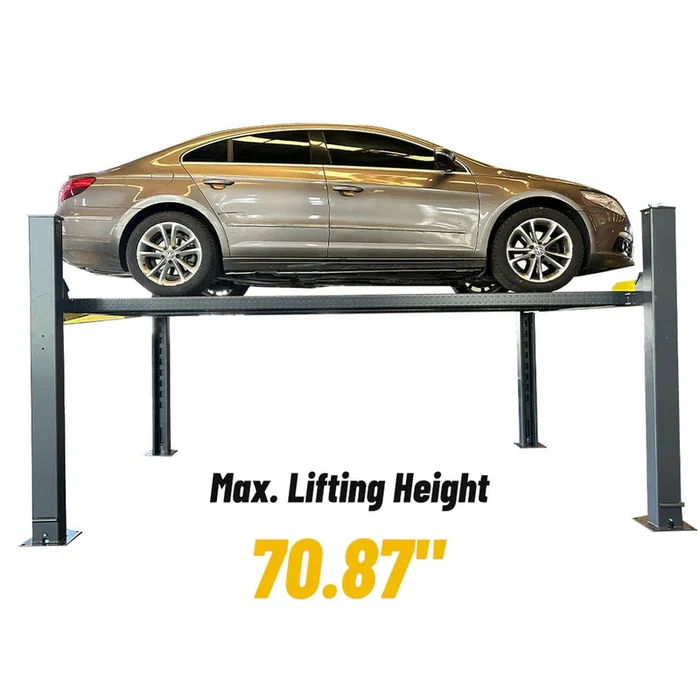
Getting down to the nitty-gritty, hydraulic car lifts have been a staple in auto shops for a while now. Hydraulics rely on a system of pumps, valves, and fluid-filled pistons to raise and lower vehicles. Picture a hydraulic lift as a well-oiled machine, literally. They function by pushing hydraulic fluid into a cylinder, which moves the pistons. This simple yet robust system has won the hearts of many mechanics.
On the flip side, electric car lifts do the heavy lifting—pun intended—by using electric motors, cables, and sensors. They operate by powering electric motors that, via a system of gears or cables, can hoist vehicles up. It’s like a heavyweight champion relying on finesse and electric energy. Electric systems tend to offer smoother, quieter operation and more precise controls, making them feel a tad more advanced in tech terms.
The science of force between the two is fascinating. With hydraulics, it’s about fluid pressure making magic happen. In comparison, electric systems use good old-fashioned mechanical advantage powered by electricity. Each method brings unique strengths to the auto world.
Both technologies didn’t just pop out of nowhere. Over the years, they evolved thanks to the growing demands of the automotive world. Hydraulic lifts, for instance, have roots in ancient devices, while electric lifts are a product of modern innovations.
Cost-wise, hydraulics often have lower upfront costs but might sneak in higher maintenance bills over time due to fluid checks and potential leaks. Electric lifts might seem pricier at first glance, but they’re often easier to maintain, which can save you pennies down the road. It’s kinda like choosing between a sturdy, old pick-up and a sleek new Prius!
Performance and Efficiency: Evaluating the Core Differences
When it comes to choosing between hydraulic and electric car lifts, the performance stakes are high. The lift’s performance can make or break how efficiently a mechanic can work. With hydraulic lifts, you typically get robust load capacities that feel pretty much indestructible. They handle heavyweight cars like pickup trucks without breaking a sweat. Meanwhile, electric lifts are no slouch either, often boasting quicker lifting speeds which can be a real game-changer when the clock’s ticking.
Energy consumption is another key factor. Hydraulic lifts rely heavily on hydraulic fluid, which can be a blessing for consistency but might not be the friendliest to your utility bills. Electric lifts, though potentially more efficient, depend entirely on electricity, which might be a greener choice depending on your energy source. In the end, it’s all about what fits your priorities best: raw power or sleek efficiency.
Durability-wise, both types can last, but hydraulic lifts require that extra maintenance love to keep them running smoothly. Keeping an eye on fluid levels and checking for leaks isn’t just recommended – it’s essential with hydraulics. Electric lifts, however, tend more towards a set-it-and-forget-it maintenance routine, though you’ll want to attend to regular motor and cable inspections to dodge any surprise expenses.
Safety is another spot where these lifts’ve got to shine. Both have built-in safety measures, but they vary. Hydraulic systems have relied on pressure fail-safes for years, while electric lifts boast sensor-driven controls that can provide more precision in locking positions. Ultimately, both offer solid safety nets, but knowing your gear is the safest bet you have.
Real-world feedback gives us some juicy insights. Folks who use hydraulic lifts often rave about their dependability and straightforward mechanics, while electric users laud the operations’ quietness and effortless precision. It really boils down to whether you’re after the tried-and-true or the cutting-edge.
Making the Right Choice: Identifying the Best Fit for Your Needs
Buying a car lift isn’t a one-size-fits-all deal—it needs to suit your unique situation. Think about where you’re gonna set up that lift. If you’re working in a personal garage, maybe space is tight or the budget is lighter. In this case, think about what you really need more often—do you need the punch of a hydraulic lift, or would an electric lift’s efficiency and low maintenance make your life easier?
For professional automotive shops, the demands are different. Speedy repairs might edge out raw power, tipping the balance toward electric lifts. The frequency of use and long hours mean reliability and easy maintenance are paramount. Either way, weigh what matches your shop’s pace and customer expectations.
Looking at this as a long-term investment is crucial too. The initial cost isn’t the full story. With hydraulic lifts, factor in regular maintenance expenses. Electric lifts might cost a bit more upfront, but their lower long-term maintenance could save you money. Plus, consider the potential resale value if you decide to upgrade or switch systems later.
Environmental impact is another factor that’s staying on the minds of many these days. Electric lifts are viewed as the greener option, especially if powered by renewable energy sources. Hydraulic lifts, particularly those using bio-degradable hydraulic fluids, can also do their part for the environment. Weigh these aspects against your own environmental values and operational needs.
The tech world is always evolving, and car lifts aren’t exempt. New innovations, like smarter controls and enhanced safety features, are on the horizon. Keeping an eye on the latest developments could give you an edge, whether that means upgrading your existing setup or snagging a state-of-the-art model down the line.
